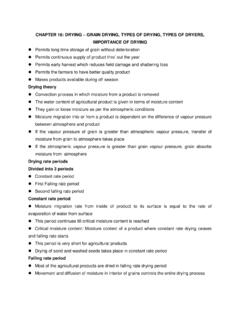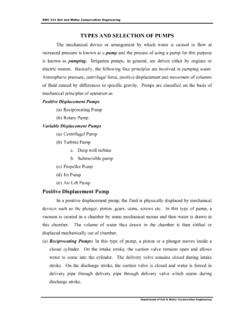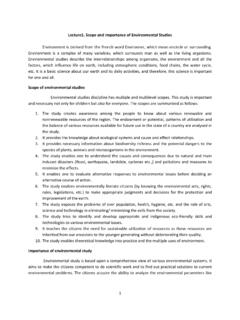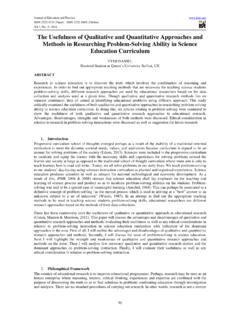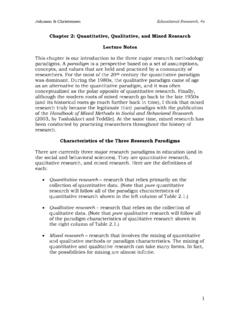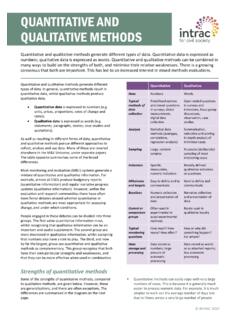Transcription of QUANTITATIVE TRAITS - QUALITATIVE TRAITS AND …
1 QUANTITATIVE TRAITS - QUALITATIVE TRAITS AND differences between them QUANTITATIVE genetics ( inheritance of multiple Genes) The phenotypic TRAITS of the different organisms may be of two kinds, viz., QUALITATIVE and QUANTITATIVE . The QUALITATIVE TRAITS are the classical Mendelian TRAITS of kinds such as form ( , round or wrinkle seeds of pea); structure ( , horned or hornless condition in cattles); pigments ( , black or white coat of guinea pigs); and antigens and antibodies ( , blood group types of man) and so on. We have already discussed in previous chapters that each QUALITATIVE trait may be under genetic control of two or many alleles of a single gene with little or no environmental modifications to obscure the gene effects.
2 The organisms possessing QUALITATIVE TRAITS have distinct (separate) phenotypic classes and are said to exhibit discontinuous variations. The QUANTITATIVE TRAITS , however, are economically important measurable phenotypic TRAITS of degree such as height, weight, skin pigmentation, susceptibility to pathological diseases or intelligence in man; amount of flowers, fruits, seeds, milk, meat or egg produced by plants or animals, etc. The QUANTITATIVE TRAITS are also called metric TRAITS . They do not show clear cut differences between individuals and forms a spectrum of phenotypes which blend imperceptively from one type to another to cause continuous variations. In contrast to QUALITATIVE TRAITS , the QUANTITATIVE TRAITS may be modified variously by the environmental conditions and are usually governed by many factors or genes (perhaps 10 or I00 or more), each contributing such a small amount of phenotype that their individual effects cannot be detected by Mendelian methods but by only statistical methods.
3 Such genes which are non-allelic and effect the phenotype of a single QUANTITATIVE trait, are called polygenes or cumulative genes. The inheritance of poly genes or QUANTITATIVE TRAITS is called QUANTITATIVE inheritance , multiple factor inheritance , multiple gene inheritance or polygenic inheritance . The genetical studies of QUALITATIVE TRAITS are called QUALITATIVE genetics. Certain Characteristics of QUANTITATIVE inheritance The QUANTITATIVE inheritance have following characteristics: 1. The segregation phenomenon occurs at an indefinitely large number of gene loci. 2. If a substitution of a allele occurs in a gene locus then such allelic substitutions have trivial effects. 3. The genes for a multiple trait have different biochemical functions but similar phenotypic effects, therefore, the phenotypic effects of gene substitutions are interchangeable.
4 4. Blocks of genes are bound together by inversions and transmitted as units from inversion heterozygotes to their progeny, but such blocks are broken up by crossing over in insersion homozygotes. 5. The polygenes have pleiotropic effects; that is, one gene may modify or suppress more than one phenotypic trait. A single allele may do only one thing chemically but may ultimately affect many characters. 6. The environmental conditions nave considerable effect the phenotypic expression of poly genes for the QUANTITATIVE TRAITS . For example, height in many plants ( , corn, tomato, pea, marigold) is genetically controlled QUANTITATIVE trait, but some environmental factors as soil, fertility, texture, and water, the temperature, the duration and wavelength of incident light, the occurrence of parasites, etc.
5 , also affect the height. Similarly, identical twins with identical genotypes, if grow up in different kinds of environments, show different intelligence quotients. Examples of QUANTITATIVE inheritance 1. Kernel Colour in Wheat Nilsson-Eble (1909) and East (1910, 1916) gave first significant clue of QUANTITATIVE inheritance by their individual works on wheat. They crossed a strain of red kernel wheat plant with another strain of white kernel. Grain from the F1 was uniformly red, but of a shade intermediate between the red and white of the parental generation. This might suggest incomplete dominance, but when F1 offsprings were crossed among themselves, the F2 zygotes showed five different phenotypic classes in a.
6 Ratio of 1 : 4 : 6 : 4:1 Noting that 1/16 of the F2 was an extreme in colour as either of the parental plants (red or white), they theorized that two pairs of genes controlling production of red pigment while operating in this cross. Each gene was supposed to contain two alleles. One allele produces a given quantity of the red pigment, while its counterpart did not produced any pigment. All alleles were equally potent in the production or lack of production of pigment. If we symbolize the genes for red with the capital letters A and B and their, alleles resulting in lack of pigment production by a and b: We can illustrate the results of this cross as follows:or 1/16 Red: 4/16 Dark: 6/16 Medium: 4/16 Light: 1/16 White.
7 P: Red White AABB x aabb Gametes: (AB)(AB) (ab)(ab) F1: Medium Medium AaBb x AaBb Noting that 1/16 of the F2 was an extreme in colour as either of the parental plants (red or white), they theorized that two pairs of genes controlling production of red pigment while operating in this cross. Each gene was supposed to contain two alleles. One allele produces a given quantity of the red pigment, while its counterpart did not produced any pigment. All alleles were equally potent in the production or lack of production of pigment. If we symbolize the genes for red with the capital letters A and B and their, alleles resulting in lack of pigment production by a and b: We can illustrate the results of this cross as follows:or 1/16 Red: 4/16 Dark: 6/16 Medium: 4/16 Light: 1/16 White.
8 P: Red White AABB x aabb Gametes: (AB)(AB) (ab)(ab) F1: Medium Medium AaBb x AaBb AB Ab aB ab AB AABB Red AABb Dark AaBB Dark AaBb Medium Ab AABb Dark AAbb Medium AaBb Medium Aabb Light aB AaBB Dark AaBb Medium aaBB Medium aaBb Light 3. Skin Colour in Man Another classical example of polygenic inheritance was given by Davenport (1913) in Jamaica. He found that two pairs of genes, A-a and B-b cause the difference in skin pigmentation between Negro and Caucasian people. These genes were found to affect the character in additive fashion. Thus, a true Negro has four dominant genes, AABB, and a white has four recessive genes aabb. The F1 offspring of mating of aabb with AABB, are all AaBb and have an intermediate skin colour termed mulatto.
9 A mating of two such mulattoes produces a wide variety of skin colour in the offspring, ranging from skins as dark as the original Negro parent to as white as the original white parent. The results of this cross are as follows : Parents: Negro White AABB x aabb Gametes: F1: Mulatto Mulatto AaBb x AaBb F2 results: Phenotypes Genotypes Genotypic Frequency Phenotypic Ratio Black (Negro) AABB 1 1 Dark AaBB, AA Bb 2 2 4 Intermediate AaBb aaBB AA bb 4 1 1 6 Light Aabb Aa Bb 2 2 4 White aa bb 1 1 These results are clearly showing that A and B genes produce about the same amount of darkening of the skin ; and therefore, the increase or decrease of A and B genes cause variable phenotypes in F2 in the ratio of 1 Negro: 4 dark : 6 intermediate: 4 light : 1 white.
10 Ab AaBb Medium Aabb Light aaBb Light Aabb White 4. Height in Man Skin colour in man is a rather simple example of polygenic inheritance because only two pairs of genes are involved. The inheritance of height in man is a more complex phenomenon involving perhaps ten or more pairs of genes. The character of tallness is recessive to shortness, thus, an individual having the genotype of more dominant genes will have the phenotype of shortness. Because, this QUANTITATIVE trait is controlled by multiple pairs of genes and is variously influenced by a variety of environmental conditions. The heights of adults range from 140 cm to 203 cm. If one measured the height of a thousand adult men and the height of each is plotted against height in centimeters and the points connected, a bell-shaped curve is produced which is called curve of normal distribution and is characteristic of QUANTITATIVE inheritance .


